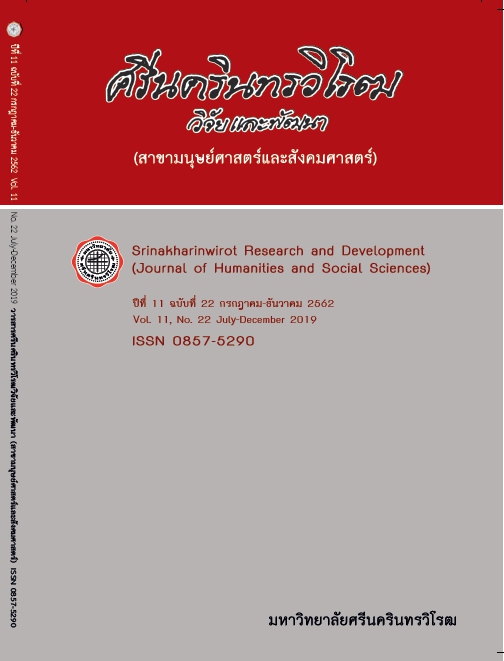พฤติกรรมการสูบบุหรี่ไฟฟ้าและพฤติกรรมต้องการเลิกบุหรี่ของนักศึกษาระดับอุดมศึกษาในเขตกรุงเทพมหานคร (E-CIGARETTES BEHAVIOR AND SMOKING CESSATION BEHAVIOR OF YOUTH SMOKER IN HIGHER EDUCATION INSTITUTE, BANGKOK)
Keywords:
E-Cigarettes Smoking Behavior, E-Cigarettes, Smoking Cessation Behavior, Youth Smoker in Higher Education InstituteAbstract
This research were mix methodology by combines parallel methods. Aims to 1) Study E-cigarettes behavior and smoking cessation behavior of youths smoker. 2) Study causal factors, processes and conditions related to E-cigarettes behavior. Collecting data by questionnaires from 422 smokers and in-depth interview by semi-structured interview from 15 smokers. Analyze data by descriptive statistic, chi-square test and multiple regression in part 1 and content analysis in part 2. and compare, link data of both part to finding the results.
Finding were 1) Most E-cigarettes youth smokers were smoke some time by only or meeting with friend. Currently smoking cigarettes by regular cigarettes and E-cigarettes together. They have wanted to quit smoking and try to had smoking cessation but do not succeed. There were 4 variables to predict the electric cigarettes smoking behavior by significantly at level 0.01 that were 1) the persons model of smoking 2) the electric cigarette products 3) the promotion of electric cigarettes and 4) the price of electric cigarettes. The cause of process to entering an electric cigarette cycle were regular smoking experience, seeing person model, receiving propaganda from friends, shop persuasion together with lack the correct knowledge were making them curious to try smoking. However, the electric cigarettes having inferior properties less than regular cigarettes both properties and prices. Most of them return to smoking and are unable to quit smoking.
Downloads
References
[2] ภัทรไพลิน จังพัฒนานนท์. (2557). รู้ทันผลิตภัณฑ์ยาสูบรูปแบบใหม่. เครือข่ายเฝ้าระวังอุตสาหกรรมยาสูบ. สืบค้นจาก http://www.tobaccowatch.in.th/know_brand_page/72
[3] Science Daily. (2019). E-Cigarette Use Linked to Successful Attempts to Quit Smoking. สืบค้นจาก https://www.sciencedaily.com/releases/2016/09/160916103436.htm
[4] ศิริวรรณ พิทยรังสฤษฏ์. (2558, 26 สิงหาคม). หนังสือพิมพ์ข่าวสด. ข่าวสดรายวัน. สืบค้นจาก http://daily.khaosod.co.th/view_news.php?
[5] S. Cooper, et al. (2019). Attitude to E-Cigarettes and Cessation support for pregnant woman form English stop smoking service: A Mixed Methods Study. International Journal of Environmental Research and Public Health. 16(110), 2-17.
[6] ปรุฬห์ รุจนธำรงค์. (2559). สถานการณ์ที่เกี่ยวข้องกับกฎหมายยา รอบปี พ.ศ. 2559. สืบค้นจาก http://www.wongkarnpat.com/viewya.php?id=2267#.XfC6N-lKjIU
[7] วงการแพทย์. (2557). บุหรี่อิเล็กทรอนิกส์ ยาสูบ “แปลงร่าง” คนบาปในคราบนักบุญ. สืบค้นจาก http://www.wongkarnpat.com/viewya.phpid=1050#.WGHc99SyOkoPOBPAD
[8] POBPAD. (2559). รู้ก่อนใช้บุหรี่ไฟฟ้า. สืบค้นจาก https://www.pobpad.comgclid=CLqurIHjgtUCFdgRaAod1a4Clg
[9] เครือข่ายเฝ้าระวังอุตสาหกรรมยาสูบ. (2557). เรื่องเด่น ประเด็นร้อน-กลยุทธ์อุตสาหกรรมยาสูบ. สืบค้นจาก http://www.tobaccowatch.in.th/hot.php
[10] ผู้จัดการ Online. (2560). บุหรี่ไฟฟ้า ทำเด็กหนีเรียนมากกว่า บุหรี่ธรรมดา พบสูบควบคู่ ไม่ช่วยเลิกบุหรี่. สืบค้นจาก http://www.manager.co.th/QOL/ViewNews.aspx?NewsID=9600000055407
[11] Ajzen, I. (2006). Constructing a TpB Questionnaire: Conceptual and Methodological Considerations. สืบค้นจาก http://www.unibielefeld.de/ikg/zick/ajzen%20construction%20a%20tpb%20questionnaire.pdf
[12] ศิริวรรณ พิทยรังสฤษฏ์, ปานทิพย์ โชติเบญจมาภรณ์, และปวีณา ปั้นกระจ่าง. (2559). สถานการณ์การควบคุมการบริโภคยาสูบของประเทศไทย พ.ศ. 2559. สำนักควบคุมการบริโภคยาสูบ กรมควบคุมโรค กระทรวงสาธารณสุข และศูนย์วิจัยและจัดการความรู้เพื่อการควบคุมยาสูบ มหาวิทยาลัยมหิดล (ศจย.). กรุงเทพฯ: เจริญดีมั่นคงการพิมพ์.
[13] ธีรวุฒิ เอกะกุล. (2550). ระเบียบวิธีวิจัยทางพฤติกรรมศาสตร์และสังคมศาสตร์. พิมพ์ครั้งที่ 5. อุบลราชธานี: คณะครุศาสตร์ สถาบันราชภัฏอุบลราชธานี
Downloads
Published
How to Cite
Issue
Section
License
Srinakharinwirot Research and Development Journal of Humanities and Social Sciences is licensed Under a Creative Commons Attribution-NonCommercial-NoDerivs 4.0 International (CC-BY-NC-ND 4.0) License, Unless Otherwise Stated. Please Read Journal Policies Page for More Information on Open Access, Copyright and Permissions.



